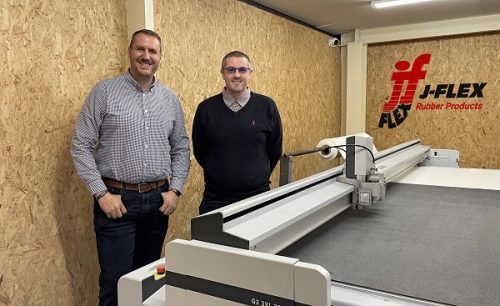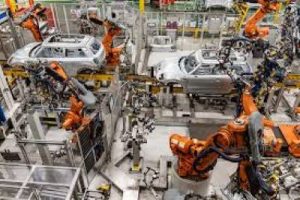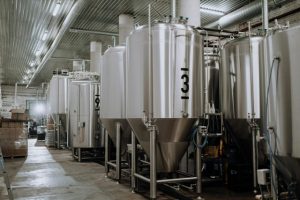‘Businesses have to be the right cultural fit for us’: Notts manufacturing boss gets on the acquisition trail

Manufacturers are facing a perfect storm of skyrocketing costs and supply chain issues, with many still struggling to recover following the disruption of the pandemic. One Nottinghamshire-based businessman is determined to buck the trend.
Having completed a management buyout of J-Flex Rubber Products earlier this month, Clockpress Holdings CEO Sam Kirk is looking forward to a bright future. We sat down with Sam to discuss his plans for the business.
Can you tell us more about the recent MBO? What drove you to make the move?
“Chris Barnes (finance director and business partner) and I have always shared an ambition to create a sustainable manufacturing business group, that aligned culturally with the values we hold and with the way we like to work. The buyout itself came about as a by-product of a wider discussion about acquisitions – an area of growth we were keen to explore and had included in our revised Vision and Strategic Plan for J-Flex in December 2021. It was while discussing the financial side of buying businesses, that the former owners of J-Flex, John & Jill Kirk, who are my parents, expressed an interest in a possible exit from the company. It was from there that we began working on a deal that allowed them to achieve that while not impacting the other acquisition plans we had already been working on.”
Clockpress Holdings was created as an investment vehicle to acquire other SMEs. How many companies are you looking to snap up and in what timeframe?
“Essentially, the acquisition plan we created for J-Flex has transferred to Clockpress Holdings. The initial plan is for five years; however we will continue to review and revise our plan as we approach each new year. In terms of the physical number of acquisitions we would like to make, who knows what the future holds. What we do have is acquisitive revenue targets in place rather than an actual number of purchases, plus the businesses have to be the right cultural fit for us.”
Speaking of growth plans, in what other ways are you planning to grow the business?
“We have targeted growth from three main areas; organic growth, distribution partnerships, and acquisitions. J-Flex has already made encouraging gains on the organic front by attracting several new blue-chip customers, as well as collaborating with several academic institutions on product improvement projects that will elevate our current offering.
“J-Flex already exports to more than 40 countries around the world and was recognised by the Department for International Trade’s Midlands Export Champion programme earlier this year, which encourages firms to consider growing through their international business with regular support and access to services. This work with businesses overseas is something we aim to continue over the coming months and years.
“All of this, we hope, will allow us to build on the foundations laid down by our original founders, which is something that is really important to us.”
Are you planning to create any jobs, and if so, how many?
“Like our acquisitions we don’t have a specific number in mind but there is certainly a hope to hire more people eventually. We are really picky about who we work with, and rightly so, as cultural fit is a massive part of our people strategy. Some might say it’s a cliché, but we believe in having the right people, on the right seats, focused on the right things. It is also our hope that as the business and group continues to grow, our people grow with it.”
You’ve reportedly completed a deal to acquire Composites Evolution. What attracted you to the business?
“We had already had some preliminary discussions with Composites Evolution about working together prior to the pandemic, so we knew that there was a good cultural fit with J-Flex already. Once we started to explore the acquisition route further it became obvious that there were some neat synergies between the two businesses in terms of customers and a profile of our clients, the markets we cover, plus the opportunity to collaborate on projects. Now working together, we can only hope to enhance the products and services we can offer to our clients going forward.”
What are the biggest challenges facing the manufacturing sector and what measures are you taking to overcome them?
“Ultimately, most of the challenges lead back to the supply chain, however the message we have reiterated to our colleagues time and again is that we need to have control over the controllables. Over the next few months there are three key areas that are going to affect our products and services the most.”
Cost of Energy
“Like many sectors and households, the cost of energy could have a considerable impact on manufacturing, and our output. While the six-month government intervention will provide some relief, many consumers will be eager to see what happens after March 2023. Where we could we have negotiated new long-term deals which are at reasonable rates for now compared to some of the horror stories we’ve heard from other business owners.”
Raw Material Availability
“As we are seeing with other sectors, some raw materials are more widely available than others which creates a knock-on effect throughout the supply chain. In some instances, the lack of availability halts production lines or reduces the requirement for other materials/products, and in other instances it creates unprecedented demand which then leads to astronomical price increases. Where possible we try to keep healthy stocks of core products and materials to help keep disruption to a minimum.”
Transport
“Post-Covid, driver shortages has meant there have been fewer vehicles available to deliver the goods, fuel prices skyrocketed which put extra pressures on businesses and the custom checks post-Brexit saw gridlocks at the ports of Calais and long delays for deliveries.
“All this has been compounded further by the recent industrial action, and it’s only likely to get worse in the run up to Christmas. While there is little we can do to control these issues we can make sure, like we do with our stock, that we are prepared and try to keep any potential disruption to our customers to a minimum. This, together with our work on costing and budgeting will ensure we are mitigating the impact the best we can.”







